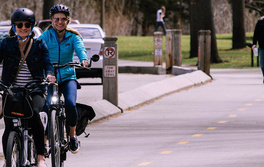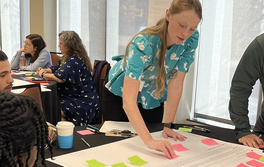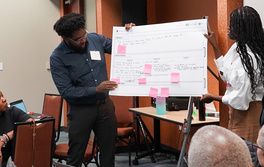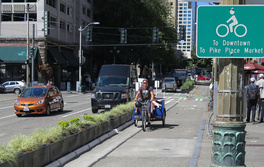
Centering Community in Infrastructure Development: A New Approach
Centering Community in Infrastructure Development: A New Approach
Historic Federal Funding Is Driving the Opportunity to Transform U.S. Infrastructure, but the Effort Must Center Communities
This piece is the first in a series exploring the opportunities presented by recent historic investments in infrastructure in the United States and the potential to transform the current status quo. You can read the next part here.
The U.S. is currently experiencing a once-in-a-generation infrastructure moment. For the first time since the 1950s, an historic surge of federal funding from the Inflation Reduction Act, the Bipartisan Infrastructure Law and the American Rescue Act presents us with an enormous opportunity to fundamentally transform American infrastructure, particularly transportation infrastructure, by addressing racial inequities, the climate crisis and long-term economic resilience.
Transformational change is not an automatic byproduct of more money, however. There is considerable risk that cities and states, which must apply to receive discretionary funding, will invest in projects that further lock us into harmful patterns of land use and transportation that continue historic trends as well as exacerbate economic and racial disparities that are leaving people behind by limiting their access to jobs, health care, education and other daily destinations and opportunities. For nearly a century, the status quo in this country has been focused on moving cars rather than people, which has created a system that is inequitable and inaccessible for so many. It’s a system that is also unsafe — pedestrian fatalities reached a 40-year high in 2021. What’s clear is that if we want better outcomes that align with community goals, values and needs, we need to disrupt that status quo.
This influx of federal funding, which represents the largest investment in public transit and non-automobile transportation in U.S. history, provides an opportunity for disruption. With these funds, the federal government is also rewriting how grants are awarded, rethinking how technical assistance is provided (and who provides it) and re-examining the metrics for program success. These changes in implementation could have broad implications for the future of transportation and mobility, equity, racial justice, access to work, health outcomes and climate resilience. Here’s how…
Transportation Decarbonization Using Equitable Solutions
Transportation must connect everyone to daily needs and services as well as economic opportunities. In almost every community in the U.S., however, we have trouble meeting that basic threshold, largely because of an overreliance on the automobile. This problem is significantly felt by the large portion of the population that doesn’t drive: children, the elderly, those with disabilities that prevent them from driving, those who cannot afford to rent or own a vehicle and those who simply do not want to drive.
For those who do drive, they often use their cars for every trip. More than half of trips taken in the U.S. are three miles or less, yet most of those short trips are taken by car, primarily because of safety concerns with other forms of transportation. A survey conducted in Melbourne, Australia, and reported in the Journal of Transportation & Health revealed that many more people would walk, bike and take scooters if they were protected from heavy vehicles in fast-moving traffic. Still, our current transportation system is increasingly characterized by a prevalence of large, heavy trucks and SUVs; distracted driving; bad road design; and growing racial and economic disparities. These concerns are especially trenchant as annual cyclist deaths have reached an alarming 20-year high, with Black cyclists being three times more likely to be killed than white cyclists.
To address these challenges, the federal government is emphasizing a new approach that centers on coordination across three key areas, as outlined in the U.S. National Blueprint on Transportation Decarbonization:
- Increasing convenience to destinations through community design and equitable land-use planning
- Improving efficiency and access to affordable, reliable public transportation
- Transitioning to cleaner options through zero-emission vehicles, commercial trucks, transit, boats and airplanes.
This also is where programs like Reconnecting Communities and Rebuilding American Infrastructure with Sustainability and Equity (RAISE), funded by the Bipartisan Infrastructure Law, come in. Both designed to shift infrastructure implementation toward prioritizing equity and sustainability, Reconnecting Communities is intended to connect communities that have been previously divided by harmful highway developments and cut off from economic opportunities, while RAISE will support communities as they build out passenger transportation infrastructure projects.
A Focus on Justice
Historically, infrastructure investments have tended toward projects and solutions that have either directly or indirectly resulted in harmful outcomes for Black and other communities of color. See Baltimore’s infamous “highway to nowhere,” Buffalo’s Kensington Expressway or Montgomery, Alabama’s Dan Ryan Expressway. The construction of highways that tore apart Black communities was no accident. These roadways were intentionally sited where land was cheap and political resistance was low. Additionally, federal grant programs have tended to favor communities with the capacity to prepare detailed grant applications and provide substantial match funds. As a result, these programs and economic development policies have resulted in a distribution of harms and benefits that routinely provide advantages to whiter, wealthier communities over Black and Brown neighborhoods.
Unlike past infrastructure bills, this recent set of legislation explicitly aims to address racial injustice by selecting locations for investment based on past harms, current economic distress, pollution burden, and lack of investment. Through the Justice40 Initiative, enacted through an executive order from President Joe Biden in early 2021, the federal government has committed to target 40 percent of particular infrastructure programs to 30 percent of all U.S. communities identified as disadvantaged through factors including transportation, health, environmental, economic, equity and climate resilience.
While this Justice40 approach is new from a sitting administration, it does not necessarily translate to other levels of governance such as at the state, local and community levels where infrastructure development normally has the largest impact. In response, national leaders with a focus on climate and development have committed to equitable implementation of this infrastructure funding, coming together through collaborations such as the Communities First Infrastructure Alliance (CFIA), to combine the strength of their efforts and more effectively organize around shovel worthy projects. Partners of CFIA include technical assistance providers, national advocacy organizations and associations that have agreed to center community-led solutions and invest in the civic infrastructure necessary for communities to implement and benefit from these solutions.
Embedding Community-Led Solutions, Values and Wisdom
To center justice, systemic barriers to robust community involvement in decision-making must be removed or circumnavigated. Infrastructure development has rarely involved meaningful community consultation. Opportunities to comment on government notices demonstrably fail to capture the attention and engagement of the most affected communities and lack systems of accountability to deliver when communities do provide comments. Infrastructure investments have regularly destroyed and divided communities of color; saddled them with high pollution burdens through proximity to heavy highway traffic, trash incinerators or sewage treatment plants; or ignored those who live in transit deserts or endure frequent floods.
Centering the vision and wisdom of those most impacted by change means ensuring that there is equity and justice in how benefits and harms are distributed across infrastructure projects, especially those that aim to address past wrongs, such as removing harmful infrastructure. Examples of equitably distributed benefits include co-investments in housing to prevent displacement, partnerships with employers to increase access to transportation and employment and a greater prioritization of funding for low-carbon transit and delivery vehicles. The end goal is to ensure that infrastructure interventions redress past wrongs, address critical needs and invest in thriving, connected, sustainable and just communities. We will further explore engagement, co-creation and communities that have succeeded in mitigating the impact of displacement in the next installment of this series.
Shovel-Worthy > Shovel-Ready Projects
Infrastructure developers and decision-makers often have a decades-old pipeline of ‘shovel-ready’ projects, most of which were conceived and planned without any climate or equity considerations. These shovel-ready projects, however, could lock us into another generation or longer of the current infrastructure status quo. That’s why there is such a focus on encouraging and selecting ‘shovel-worthy’ projects that center equity and community needs. A project is considered shovel worthy if it is part of a larger community plan, involves community engagement, and effects positive change. Where shovel-ready projects are centered around delivery of a project, shovel-worthy projects aim to deliver beneficial outcomes for the surrounding community.
This historic influx of funding represents an unprecedented moment to shift the infrastructure status quo and center the needs, aspirations and wisdom of communities that are most impacted by infrastructure decisions. Since the need to address systemic, ongoing inequities with justice-led approaches is urgent, long term and multiscalar, we need new approaches that challenge the business-as-usual mode and shift space at the table toward community-centered co-creation.
In the second part of this series here, we explore how communities are getting involved and exercising their agency over funding decisions through examples of successful, community-led, shovel-worthy infrastructure projects.
This post was authored by Justyn Huckleberry, research and projects analyst for NUMO.
Header image: Corey Templeton/Flickr




